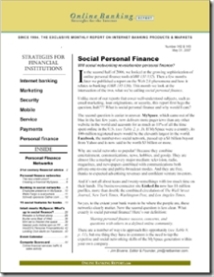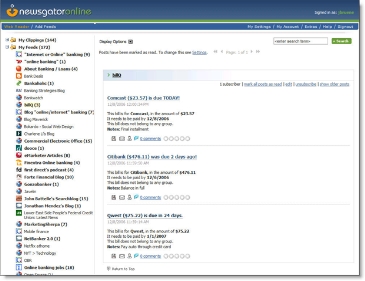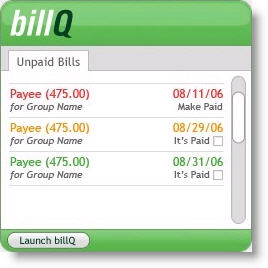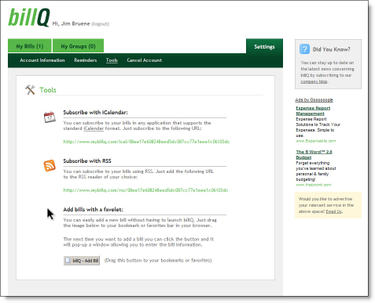Update March 6: I added two clarifications pointed out in the comments. First, that normal ACH deposits to your own SmartyPig account are free of charge. Second, that the retailers bonus on withdrawals to their gift cards is UP TO 5% (not a flat 5%).
 How about this recipe? Take a basic FDIC-insured savings account, spice it up with automated electronic transfers and email communications, mix in gift/debit cards, wrap the whole thing up in a social network, and top it with a memorable name. What do you have? SmartyPig, the most innovative financial service we've seen since Prosper launched two years ago.
How about this recipe? Take a basic FDIC-insured savings account, spice it up with automated electronic transfers and email communications, mix in gift/debit cards, wrap the whole thing up in a social network, and top it with a memorable name. What do you have? SmartyPig, the most innovative financial service we've seen since Prosper launched two years ago.
The site is in the final week of private beta. To register, you still need an invitation code. The company asked me not to publish it, but it's OK if I distribute by request via email. Send a note to info@netbanker with "SmartyPig" in the subject line. Or simply wait until after this weekend when the site goes into public beta.
How it works:
 1. Users create savings accounts at the site. Deposits are held at West Bank, a Des Moines, IA- based financial institution with $1.3 billion in assets. Funding is through ACH (electronic) transfers from outside bank accounts. SmartyPig currently pays a high, 4.3% APY on deposits.
1. Users create savings accounts at the site. Deposits are held at West Bank, a Des Moines, IA- based financial institution with $1.3 billion in assets. Funding is through ACH (electronic) transfers from outside bank accounts. SmartyPig currently pays a high, 4.3% APY on deposits.
2. After the account is established, users are encouraged to create savings goals funded through automatic monthly ACH transfers until the goal is met.
3. Now here is where SmartyPig diverges from a typical bank account. The savings goals can be made public or kept private. Public goals can be funded in part, or entirely, by outside contributors. Think of grandma and grandpa contributing birthday money to help junior buy a new bike. Contributions are funded through credit card charges with a maximum charge of $500 and a per transaction processing fee of $4.95. To make sure grandma's $50 doesn't go to a Mario game, the money cannot be withdrawn until the savings goal is met (or canceled by the primary account holder).
4. After goals have been met, the user can elect to take the funds out in the form of a MasterCard debit card or a gift card from a retail partner such as Amazon.com. Participating retailers add up to 5% bonus to the savings goal so that $1000 saved for the plasma TV is worth $1,050 if redeemed via Amazon gift card. That's a great added incentive to use the service.
Gift Cards
 SmartyPig also sells gift cards that can be redeemed towards new or existing savings goals. These cards, issued in denominations of $25 to $500, are meant to be given as gifts or employee incentives. They cannot be redeemed outside the SmartyPig system. Physical card are produced and delivered for a processing fee of $4.95 plus delivery fees of $5.95 or more. Or consumers can deliver a virtual card through email to eliminate the delivery charge (but the $4.95 processing fee remains the same).
SmartyPig also sells gift cards that can be redeemed towards new or existing savings goals. These cards, issued in denominations of $25 to $500, are meant to be given as gifts or employee incentives. They cannot be redeemed outside the SmartyPig system. Physical card are produced and delivered for a processing fee of $4.95 plus delivery fees of $5.95 or more. Or consumers can deliver a virtual card through email to eliminate the delivery charge (but the $4.95 processing fee remains the same).
Summary of Fees
- Your own deposits: Free (via ACH transfer)
- Public contributions: $4.95 flat processing fee for each contribution made by an outside contributor. Contributions can be from $25 to $500 and are funded via credit card.
- Gift cards: Gift cards incur a $4.95 processing fee and an optional $5.95 shipping fee. The shipping fee can be avoided if a virtual gift card is chosen which is fulfilled via email.
Analysis
Although, not everyone is going to want to go through the extra steps to save this way, we are impressed with SmartyPig and are awarding it our first OBR Best of the Web award for 2008  (see note 1). We like how it's part gift registry, part savings account, and potentially a big help in getting users in the habit of saving for larger goals. The look-and-feel is very Web 2.0 and should resonate with teens and twenty-somethings.
(see note 1). We like how it's part gift registry, part savings account, and potentially a big help in getting users in the habit of saving for larger goals. The look-and-feel is very Web 2.0 and should resonate with teens and twenty-somethings.
There are a few rough edges that need better explanation and/or minor redesign. For instance, there is no way to simply add funds to a savings account without first setting up an automatic funding plan. But the site isn't even officially launched yet, so these issues should be ironed out during the beta period.
The processing fee for outside contributions of $4.95 per transaction is a bit on the high side (there is no fee for funds transfers from your own bank account). One could argue that it's worth price of a triple mocha for the convenience and benefits of the savings account. But for smaller deposits of $50 to $100, it's a pretty high percentage of the overall deposit.
It would be nice if the company could lower the fee, perhaps by creating an ACH funding option. Another way to reduce costs is to lower the 4.3% APR. I'm not sure the savers attracted to this account really need that high of a rate. A lower interest rate combined with lower fees might make the service more palatable overall.
The company may have to tweak its business model going forward. But the real lesson here is that savings accounts can be made stickier with automation and incentives. Leave it to the Iowans to show us the way (note 2).
Screenshots
1. The main account screen: I set up a savings account for my son. Then set a savings goal of $300 for a new bike. SmartyPig requires that the savings goal be funded in equal monthly withdrawals from the linked checking. It would be helpful if you could opt out of the automated savings plan so that the savings goal could be funded manually.

2. Public goals: If you opted to make your savings goal public, anyone can find it by searching via email address under the "Friends' Goals" tab on the top (you can see this one by searching for [email protected]). 
Users can publicize their goals with a widget (see inset, and link at bottom of screen above) or by sending email to friends.
After making a contribution, the following screen is displayed.

Note:
1. Online Banking Report (OBR) Best of the Web awards are given for products that "raise the bar" in online financial services, usually for pioneering a new feature. Recent winners are covered here. Five awards were been handed out in 2007: two for Wesabe, and one each for Jwaala, Buxfer and Obopay. In the past 10 years, 67 companies have won the award.
2. Full disclosure: I was born and raised in Iowa and my brother lives within a few miles of the SmartyPig world headquarters.
 With bad news pouring down from all corners of the financial services world, it’s a difficult time to be a bank marketer no matter what condition your financial institution is in (see note 1).
With bad news pouring down from all corners of the financial services world, it’s a difficult time to be a bank marketer no matter what condition your financial institution is in (see note 1).  But besides sending reassuring emails to your customers, highlighting your strong balance sheet on your website (see inset), and for the few with blogs, dropping the occasional rosy post into the RSS or Twitter feed (note 2), what’s a banker to do?
But besides sending reassuring emails to your customers, highlighting your strong balance sheet on your website (see inset), and for the few with blogs, dropping the occasional rosy post into the RSS or Twitter feed (note 2), what’s a banker to do? Online Banking Report publishes Security 4.0 (note 3)
Online Banking Report publishes Security 4.0 (note 3) We also take a closer look at Bank of America’s SafePass (previous post here), which is an easy way for customers to add an extra security layer to their login, although it won’t prevent certain malware to hijack the session. See the inset for the complete Table of Contents.
We also take a closer look at Bank of America’s SafePass (previous post here), which is an easy way for customers to add an extra security layer to their login, although it won’t prevent certain malware to hijack the session. See the inset for the complete Table of Contents.
























 For the past few months, I've been more or less obsessed with RSS feeds (see our latest full report on the subject
For the past few months, I've been more or less obsessed with RSS feeds (see our latest full report on the subject 








